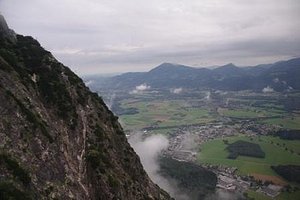Advertisement
Published: August 29th 2017

 The Untersberg Cable Car
The Untersberg Cable Car
View from the cable car about half way up the mountain. Geo: 48.1391, 11.5802
After leaving Salzburg, we headed to Untersberg, to take the cable car to the top of the mountain. The cable car climbs to an altitude of 1320 m, with the largest distance from the ground being 286m, and an enormously long free-hanging span of 1.548 km between the valley station and the first tower. Some amazing views from the top of the Untersberg.
Then we headed off to our tour of Hitlers bunkers and Berchtesgaden, the Eagles Nest. This tour took 4.5 hours with our tour guide giving a very informative talk on the bus and right throughout the afternoon. The tour guide was the same one that took Britt and the Harris' on their Eagles Nest Tour last year.
The Eagles Nest, the road leading up to it and the lift inside the mountain were completed in just two years in 1938 under the guidance of none other than Martin Bormann, as a fiftieth birthday present for Adolph Hitler. The road has in places a 27 degree gradient, and is a tribute to German and Italian engineering.
Eva Braun used to spend most of her time at the Eagles Nest, hiking and sun bathing. The German people did not

 Bunkers at Berchtesgaden
Bunkers at Berchtesgaden
Some of the bunkers that were hidden underground on the mountain. Each house or barracks had tunnels such as these underrneath, all linked except Bormann's and Goering's, who hated each other. know of Eva's existence until after the war. Hitler wanted to portray an image of being a god like figure who did not need a companion. Even his propaganda posters portrayed him with a dove above his head, with streams of light shining down from the clouds onto his head.
Hitler only came to the Eagles Nest fourteen times, as he was claustrophobic and scared of heights.
Gifting the Eagles Nest to Hitler was Bormann's way of gaining approval and funding for the project. Bormann spent most of his time at Berchtesgaden.
Going through the bunkers was a little eerie, and seeing the SS Guard Posts at each point in the tunnels, and at each road entry point to the mountain, made the experience come to life. The road ends around 450 metres below the summit, where it heads into an underground tunnel. This was because the road was at that stage above the treeline and couldn't be hidden from view. At the end of the tunnel was a massive gold plated lift that took Hitler and his cronies to the Eagles Nest. The only other way up to the top is a narrow trail that Eva Braun often used

 Tunnel Leading to the Underground Lift
Tunnel Leading to the Underground Lift
This tunnel was wide enough for Hitler's car to take him to the base of the gold plated lift, which took him directly to the Eagles Nest. to walk up and down the mountain.
The view from the top is amazing. Hitler called Germany the Fatherland, and Austria, which can be seen down the valley, the Motherland. Hitler was of course born in Austria.
Tomorrow we are off to Dachau, the Concentration Camp that became the "model" for all of the Concentration Camps throughout Europe.
Jim and Kim
Advertisement
Tot: 0.056s; Tpl: 0.01s; cc: 6; qc: 28; dbt: 0.036s; 1; m:domysql w:travelblog (10.17.0.13); sld: 1;
; mem: 1mb

 The Untersberg Cable Car
The Untersberg Cable Car
 Bunkers at Berchtesgaden
Bunkers at Berchtesgaden
 Tunnel Leading to the Underground Lift
Tunnel Leading to the Underground Lift


